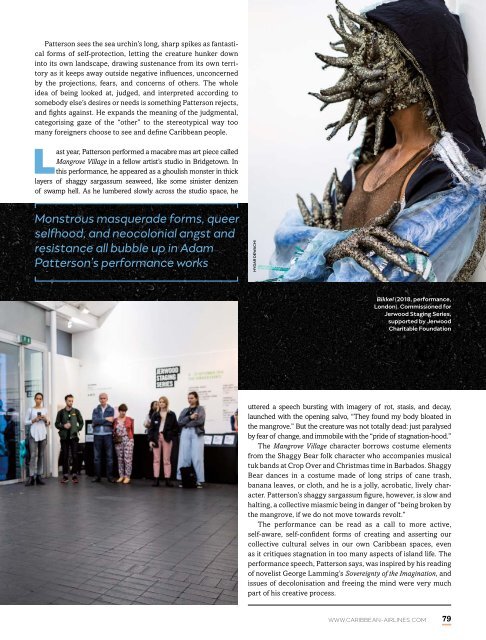Caribbean Beat — January/February 2019 (#155)
A calendar of events; music, film, and book reviews; travel features; people profiles, and much more.
A calendar of events; music, film, and book reviews; travel features; people profiles, and much more.
You also want an ePaper? Increase the reach of your titles
YUMPU automatically turns print PDFs into web optimized ePapers that Google loves.
Patterson sees the sea urchin’s long, sharp spikes as fantastical<br />
forms of self-protection, letting the creature hunker down<br />
into its own landscape, drawing sustenance from its own territory<br />
as it keeps away outside negative influences, unconcerned<br />
by the projections, fears, and concerns of others. The whole<br />
idea of being looked at, judged, and interpreted according to<br />
somebody else’s desires or needs is something Patterson rejects,<br />
and fights against. He expands the meaning of the judgmental,<br />
categorising gaze of the “other” to the stereotypical way too<br />
many foreigners choose to see and define <strong>Caribbean</strong> people.<br />
Last year, Patterson performed a macabre mas art piece called<br />
Mangrove Village in a fellow artist’s studio in Bridgetown. In<br />
this performance, he appeared as a ghoulish monster in thick<br />
layers of shaggy sargassum seaweed, like some sinister denizen<br />
of swamp hell. As he lumbered slowly across the studio space, he<br />
Monstrous masquerade forms, queer<br />
selfhood, and neocolonial angst and<br />
resistance all bubble up in Adam<br />
Patterson’s performance works<br />
Hydar Dewachi<br />
Bikkel (2018, performance,<br />
London). Commissioned for<br />
Jerwood Staging Series,<br />
supported by Jerwood<br />
Charitable Foundation<br />
uttered a speech bursting with imagery of rot, stasis, and decay,<br />
launched with the opening salvo, “They found my body bloated in<br />
the mangrove.” But the creature was not totally dead: just paralysed<br />
by fear of change, and immobile with the “pride of stagnation-hood.”<br />
The Mangrove Village character borrows costume elements<br />
from the Shaggy Bear folk character who accompanies musical<br />
tuk bands at Crop Over and Christmas time in Barbados. Shaggy<br />
Bear dances in a costume made of long strips of cane trash,<br />
banana leaves, or cloth, and he is a jolly, acrobatic, lively character.<br />
Patterson’s shaggy sargassum figure, however, is slow and<br />
halting, a collective miasmic being in danger of “being broken by<br />
the mangrove, if we do not move towards revolt.”<br />
The performance can be read as a call to more active,<br />
self-aware, self-confident forms of creating and asserting our<br />
collective cultural selves in our own <strong>Caribbean</strong> spaces, even<br />
as it critiques stagnation in too many aspects of island life. The<br />
performance speech, Patterson says, was inspired by his reading<br />
of novelist George Lamming’s Sovereignty of the Imagination, and<br />
issues of decolonisation and freeing the mind were very much<br />
part of his creative process.<br />
WWW.CARIBBEAN-AIRLINES.COM<br />
79


















